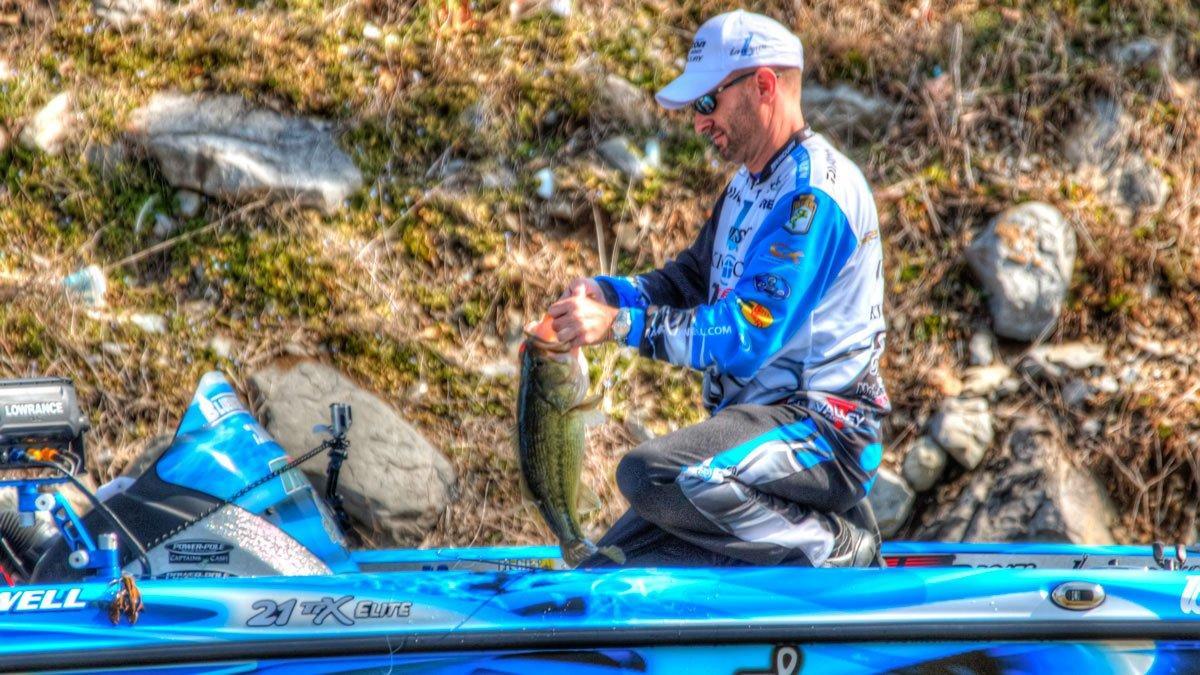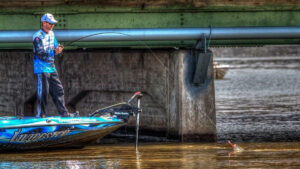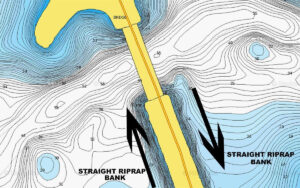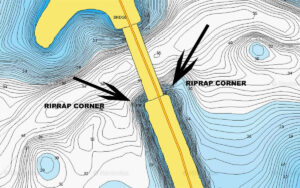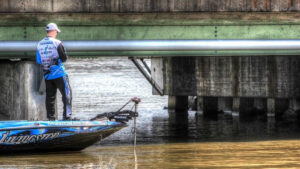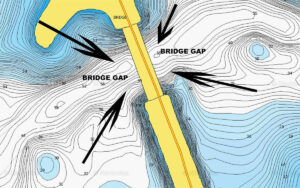We’ve all been there at some point in time—we try everything we know throughout a day of fishing and can’t seem to buy a bite. The weather is beautiful, our hopes are high and for reasons often beyond our understanding, the bass simply won’t cooperate. Our proverbial bubble is indeed busted.
But before giving up and heading home, however, consider a technique that has helped shape Elite Series pro Randy Howell’s career. You won’t have to spend hours idling around looking for that “magic” structure or cover and you don’t need to get too carried away with complicated map study. According to him, bridges are easy-to-find bass fishing hotspots throughout much of the year.
In order to duplicate the Bassmaster Classic-winning success Howell has enjoyed fishing bridges, there are a few important factors to understand.
- Why bridges hold bass
- Details are everything
- Four key spots to target
Interstates and rest areas
If you’ve ever made a long drive down the interstate, you know how valuable a strategically placed gas station or restaurant is. After a long stretch of barren road, we flock to and congregate in these areas for two primary reasons—rest and food. Bass behave in a very similar manner in regards to bridges.
“When bass are moving to and from deep water, they may not have much cover or many feeding opportunities for quite a while,” Howell said. “So when they finally reach one of these bridges, they’re able to enjoy and take advantage of everything they could possibly need. The shad are essentially on a silver platter for them as they eat the plankton and algage from the rocks and pilings, crawfish are hiding in the rocks and there are plenty of safe hiding spots for bass to utilize.”
In addition to these bridges acting as a one-stop-shop for bass, they also serve as a constriction point during their seasonal migrations. Bass can’t jump over the road to get to the other side, so as you could guess, they are forced to swim through the narrow gaps in order to reach new water.
“Bridges funnel bass through a very small and predictable area,” Howell said. “It’s just like your bedroom door—if you want to leave the room, you have to go through the door. This makes bridges consistently productive because bass are constantly moving through them. Even if you’re not in the middle of a major migration, there will still be bass in the area. Sometimes they just hang around for a long period of time because they have it made.”
Details can make or break you
As is often the case with many bass fishing techniques, details are paramount to Howell’s bridge fishing success. It’s not impossible to catch a few fish with a haphazard approach, but if you pay close attention to the small things, you can get well in a hurry.
“Details are incredibly important whenever you’re targeting bridges,” Howell said. “In a sense, it’s just like the police raiding the house of a suspected criminal. They know they’re in there, but they have to make sure they have everything right before they bust in on ‘em. There’s a great chance you’re going to be around a concentration of quality bass, so you don’t want to mess things up.”
- Bait— We’ve all heard it until we’re blue in the face—find the bait, find the bass. But according to Howell, the presence of bait around bridges isn’t much of a question. Your first order of business, however, is deciphering the depth of the bait. Howell looks for balls of bait on his Lowrance units and adjusts his gameplan accordingly. If the bait is suspended, he expects the bass to follow suite. Similarly, when the bait is tight to the bottom, he’ll often utilize bottom-contact presentations to fool nearby bass. His rule of thumb is fairly simple—don’t use anything that goes below the bass or more than 3 or 4 feet above them.
- Sound— “I’m a huge believer in sound, especially when the bass and bait are suspended on or around bridges,” Howell said. “I’ll use my Livingston Lures Howeller and Howeller Plus and set them on the ‘fleeing shad’ sound while also dialing up my Hydrowave. These suspended bass can be tricky at times, but that added sound will cause them to travel a longer distance to eat your lure and it can fire up that school right after just a few casts.”
- Stealth— Because most bridges are known for having a “sweet spot” in which the majority of the bass congregate, Howell stresses the importance of stealth. These areas get a lot of pressure from anglers and are often exposed to a great deal of boat traffic, so the bass can be a bit spooky. To increase your stealth, concentrate on making long casts and avoiding hang-ups whenever possible. The further you can keep your boat from the bass, the better chance you’ll have of igniting a school of nice bass. Sometimes a simple mishap, like a snag, is all it takes to scatter the fish and make them largely uncatchable.
Straight riprap banks
Perhaps the most popular and highly pressured parts of a bridge, straight riprap banks can be enormously productive throughout much of the year. This is where Howell most often starts his bridge dissection.
“I’m always going to parallel the riprap and get my boat right against the rocks,” Howell said. “I’ll start with a shallow Livingston Lures Primetyme SQ 2.0 and if I start getting bites, that tells me that I’ve found the most productive strike zone. I’ll keep landing my casts right next to the rocks so I can put my crankbait in front of as many fish as possible. If I’m not getting bit, I’ll keep throwing parallel, but I’ll slide out a bit deeper and start throwing my Howeller crankbait on 10-pound Gamma Edge Fluorocarbon.”
- Water clarity— Visibility plays a big role in Howell’s approach. If the water is stained, he spends most of his time with his boat close to the rocks focusing on the 3 to 5-foot range because the fish tend to position shallow and become easier to catch. In clear water, however, it can be more difficult to pinpoint riprap bass due to the fact that they’ll often hold a bit deeper and farther away from the rocks. In this case, he’ll targer the underwater transition where the riprap ends and turns into a smoother bottom.
- Irregularities— “When I’m fishing a long, straight stretch of riprap, I’m going to make repeated casts towards anything that’s different,” Howell said. “It could be a big boulder, a small point where the rock protrudes a bit further into the water or even a small grass bed. These are all key ambush points and when you catch one from an area like this, another fish will take its place. So when you can find these key irregularities that hold fish, you can come back to them throughout the day and keep catching fish.”
- Lure movement— When you’re cranking riprap, it can be easy to become a robot and start staring off into space. But if you’re able to pay close attention to the movement of your crankbait, you can often find key irregularities you’re unable to see with your naked eye. Howell constantly watches his line for any unnatural movements. When he sees his line roll up towards the top or jolt to the side, that tells him that his crankbait has found a larger rock which can serve as a potential ambush point for feeding bass.
Riprap corners
The corners of riprap—where the straight bank turns underneath the bridge itself—are arguably the most high-percentage bass fishing spots on bridges. Both wind current and natural current will wash bait past these areas, creating a virutal buffet for bass.
“I always try to ease up on the corners as I’m coming down the straight stretch of riprap,” Howell said. “Basically, I’m casting into the deeper water and bringing my bait shallower and into the corner. This is a very natural presentation that perfectly imitates the behavior of baitfish in current.”
- Current— The presence of current is paramount when fishing the corners of bridges. The water movement will do two important things—position baitfish and stack bass into very small and predictable areas. When Howell notices a fair amount of current, he’ll spend a lot of time on these corners because he’s ultra-confident the bass are in the immediate vicinity. He primarily focuses on the downstream side of the current to give his bait a more natural presentation, but he won’t totally rule out the upstream side. Not all bass behave in the same manner, so he believes it’s important to keep them honest.
- Wind— “I’ll usually start on the windy corners,” Howell said. “The ripple on the water breaks up your lures profile and makes it appear more natural to the bass. You’ll rarely catch ‘em on the calm side if there’s a windy side available.”
- Backup plan—Calm winds and clear skies can make this type of fishing much more difficult, but not impossible. In these conditions, Howell relies on bottom-contact presentations such as a 3/4-ounce Lunker Lure Ultimate Rattling Jig with a Yamamoto Double Tail Grub trailer. After thoroughly dissecting the area with his jig, he’ll use a Lunker Lure Magnum Shakey Head with a 7.5-inch Yamamoto Kut Tail Worm to clean up the more inactive fish. Unfortunately, bridge corners can “catch” a lot of snag-inducing cover and discarded fishing line, so it’s important to stay patient. You’ll get snagged more often while fishing on the bottom, but it’s an excellent way to combat tough conditions.
Pilings
If you’re unable to find a consistent bite on the straight riprap or corners, be careful not to overlook the pilings of the bridge. The monstrous concrete structures may seem a bit intimidating to fish, but there are times when the bass will favor them over anything else in the lake.
“It’s hard to predict when it will happen, but a good piling bite is totally possible,” Howell said. “I think it might have to do with the gizzard shad—they’ll start feeding on that algae and you can actually see giant schools of them. This patterns seems to happen primarily when the water is calm because the gizzards can feed without fighting the current.”
- Vertical presentations—Howell most often relies on sinking, vertical presentations when targeting pilings. He’s enjoyed a lot of success recently using the Livingston Lures School Master—a shad-shaped lure that moves like a soft jerkbait but sinks at roughly 1 foot per second when paused. He’ll cast it directly next to the piling and watch his line as it sinks. When it stops falling, he immediately sets the hook.
- Horizontal presentations— “If the bass aren’t responding to vertical presentations, I’ll definitely try a horizontal presentation, such as a swimbait, before I leave the area,” Howell said. “But it’s very important to continuously experiment with different depth zones because the bass will position at very specific levels. If you can key in on a certain depth range, you can go to the adjacent pilings and keep catching fish. Remember, however, that each bridge is different, so you’ll need to find the most productive depth range on each individual bridge.”
Bridge gaps
Although largely overlooked, the gaps—or holes—of bridges can be great places to catch late post-spawn and summer bass. When the water temperatures begin to skyrocket, Howell makes a concerted effort to fish these areas with a myriad of different lures.
“A lot of anglers discount the effectiveness of bridge gaps,” Howell said. “But I’ve had some incredible luck on them. The bass are simply relating to the big shad schools that hang out in the channel, making shad-imitation baits my primary choice.”
- Timing— Timing is everything in this situation. The fish in these areas will not feed throughout the entire day. In fact, all of the action can occur in a matter of minutes. For this reason, Howell makes sure to fish these gaps when current is present. According to him, the first few minutes after the current begins is the prime time to fish bridge gaps.
- Shad, shad and more shad— “I like to use several different lures in this situation,” Howell said. “A lot of times, I’ll cast a Blakemore Randy’s Swim’n Runner way underneath the bridge, let it sink to the bottom and slow-roll it down the channel. I also like to use deep crankbaits such as the Livingston Lures Deep Impact 18 crankbait, big flutter spoons and larger swimbaits. I switch a lot because once you catch one on a certain lure, these bass will become accustomed to it. You have to keep rotating through your arsenal to show them something different.”
- Surface activity— Although most bridge gaps you’ll find are over 20 feet deep, you’d be surprised by the topwater action that can occur. Howell watches closely for any shad activity on the surface and when he sees even the smallest flicker, he’ll cast a Livingston Lures Walking Boss on 70-pound Daiwa Samurai Braid towards the commotion.
The next time you’re having trouble putting together a solid bass fishing pattern, spend some time dissecting bridges before heading home. Sure, they stick out like a sore thumb and get lots of pressure, but Howell’s secrets will help you catch plenty of bass behind your fellow anglers.


